

I’ve stood on the cliff edge overlooking the Cape Greco sea caves so many times. I’ve stared wistfully at the huge open mouths of the caves beneath, camera on full zoom to catch a glimpse inside the dark interiors. Nothing. I’ve spent hours trawling through internet pages trying to find photos that will show me what the caves are like inside. Very little.

I’ve never attempted to explore them for two reasons:
1) I thought they were inaccessible, except by boat or cliff-jumping. Matt discovered earlier in the year that it is actually fairly easy to climb down the cliff beneath the famous ‘window’. At low tide there is an exposed shelf of rock running along the bottom of the cliffs that will take you to the caves.

2) Once we realised that we could climb down the cliffs, this is the second reason why we didn’t:

And this:
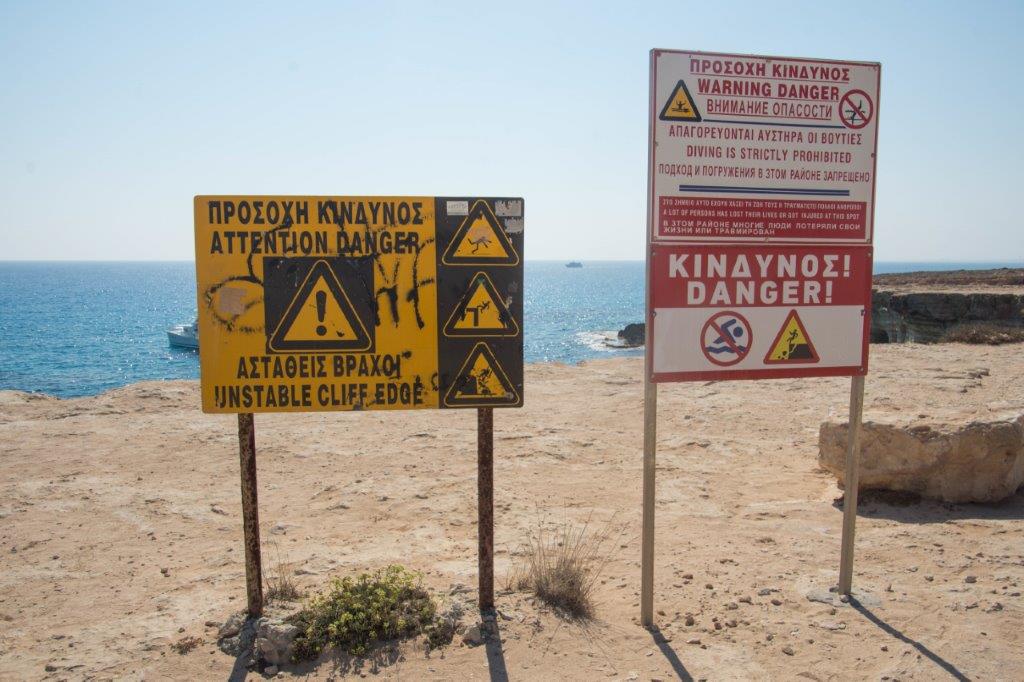
And then I read an article reporting that the government were thinking of fencing off the cliffs due to the threat of imminent collapse.
Bugger.
I now had a deadline. If I wanted to get inside those caves, I needed to go pronto before they were closed off.
But the thought of cliffs falling on my head and orphaning my children sat a tad uncomfortably with me.

‘Those caves have been standing for thousands of years,’ said Matt. ‘We’d have to be pretty unlucky for them to fall down the day we are there.’
Matt doesn’t give a stuff about caves, but he can be relied on to be rational.
Oh all right then, if you insist.
We booked our babysitter for an entire day and set off on our Date Day to the Cape Greco sea caves. I made sure our friends knew where we were going. In case we didn’t return.

So, any fear of imminent death was immediately squashed as soon as we got there. Not only were there loads of people cliff-jumping and exploring the caves beneath, there was even a lifeguard in situ. Slightly undermines the no-jumping-no-climbing message, don’t you think?

We’d timed our visit for low tide when we could reach the caves via the rock shelf instead of having to swim. I packed over £2000 worth of camera-related equipment into a bag and headed down the cliff edge. ‘If I slip,’ I said to Matt, ‘save the camera.’

It was actually really easy getting down and walking along the rock shelf to the first cave. The rocks were slippery and sharp, but my sea shoes have a good grip. Above me, cliff-jumpers threw themselves off the edge and into the sea below. People get injured here every year doing this.

Running around the top of the cliffs was a lip of thin, fragile-looking rock.
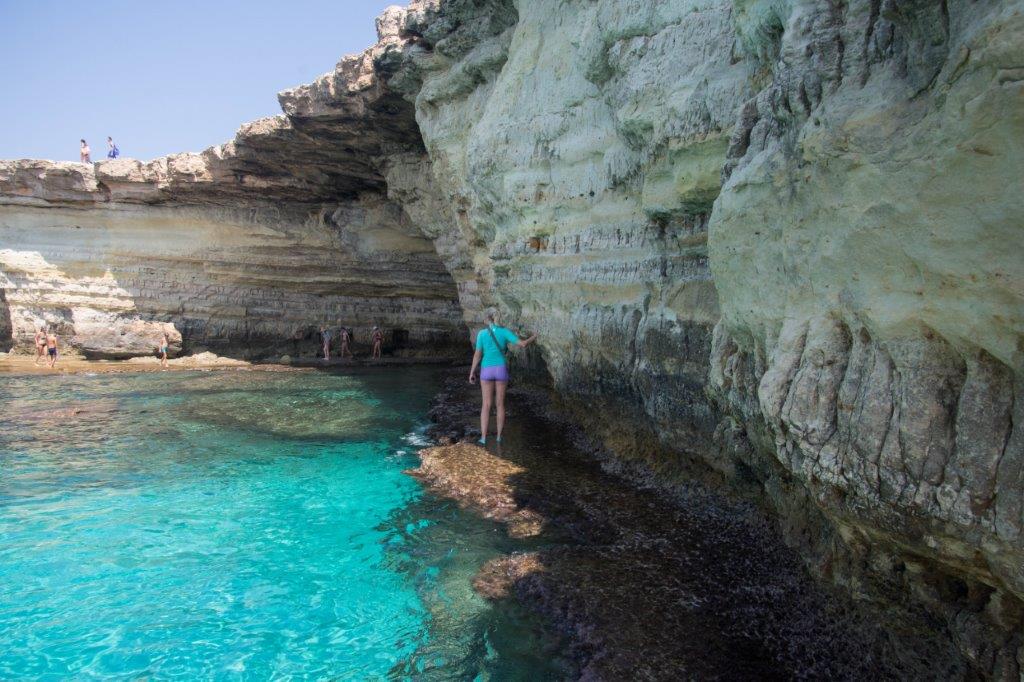
The first sea cave we reached is in the eastern corner of the cove and is MASSIVE!!! I turned the corner and looked inside. OMG, it was I.N.C.R.E.D.I.B.L.E.

Just inside the massive entrance, two channels led into darkness; one huge, one very low. I was itching to get inside, to see how far back they went, but I had to wait while two beautiful women wearing thong bikinis took pictures of their bums. They turned this way and that, making sure the lighting flattered the contours of their buttocks. I was nearly jumping up and down with impatience. We christened this cave The Bum Cave. While I waited, I peered into the smaller channel to my right. The ceiling was very low so I didn’t fancy wading into it.

Finally the bum photos finished and we had the massive channel to ourselves. The roof soared above my head, rock strata that looked like pillars held up a v-shaped ceiling. It was beautiful.

We headed into the cave. You need a good torch to explore this place otherwise you’ll be in total darkness pretty soon. In places you have to wade through water, though it didn’t reach higher than my thighs.

We looked back and saw we’d already come a fair way and the end wasn’t in sight yet.

As we headed deeper into the cave we had to climb out of the water and up across a rocky floor. The vertical columns of rock stretched far upwards into the dark.


Soft, black goo covered some of the rocks. Guano? Oil?

As we continued on, the rocks flattened out and looked almost like a man-made cobbled road.
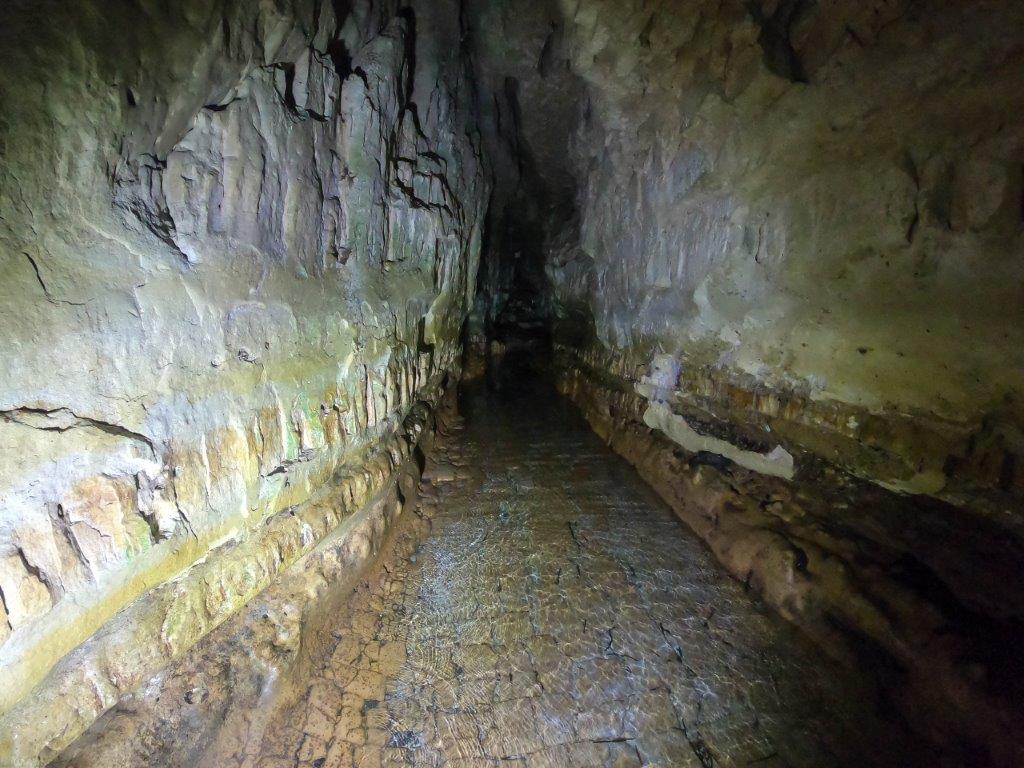
Finally we could see the end where the walls narrowed and the ceiling lowered to a tapered nook.
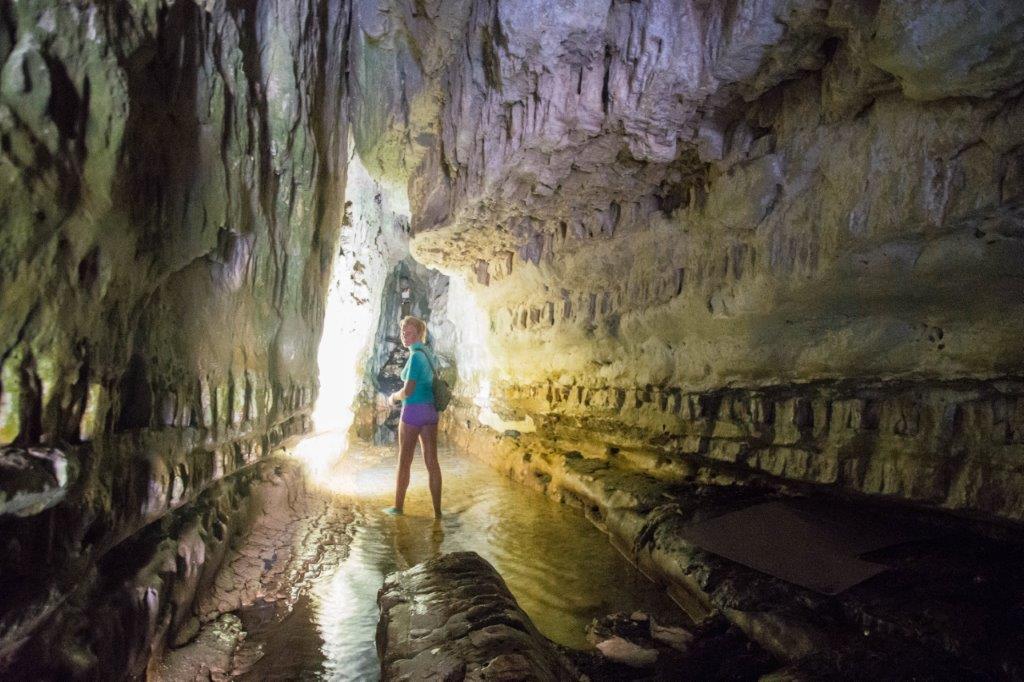
The nook was filled with crap. Plastic crap, rope crap, this crap, that crap.
No pot of gold. No magical portal into a subterranean kingdom.
Just the very end of a bloody brilliant cave-tunnel.

I looked back at the entrance, just a small patch of light in the distance. This cave must be approaching 100m long.

We took a gazillion photos – though not of any bums. Then we headed back towards the light, all thoughts of cave-collapse very far from our minds.

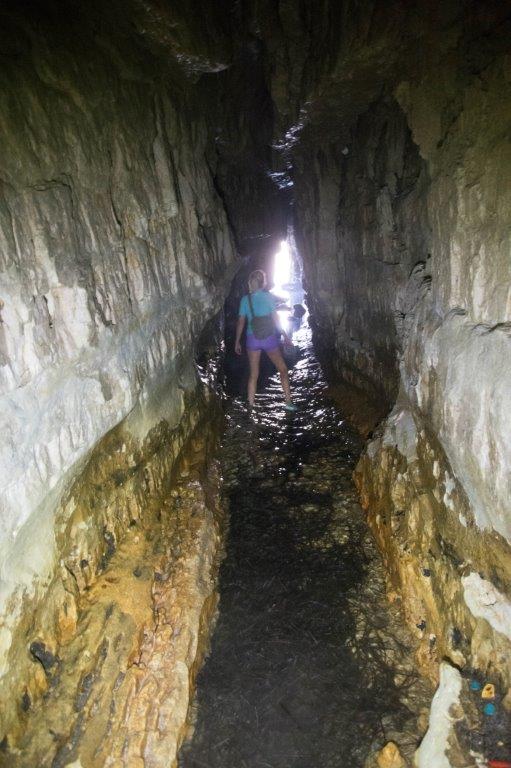


Once out of the main cave, we picked our way over the slippery, rocky shelf and followed the contour of the cove as it curved round. Ahead of us, numerous caves beckoned us in.

The rocky shelf is covered in a yellowy sea weed and pitted with some excellent rock pools. Goobie and Herc would have loved them. We saw fish, shrimp and crabs in these pools.

But our focus was on the caves and, as we walked round, I quickly saw that what I thought had been dozens of big caves were in fact just shallow caves and nooks cast in shadow. Nonetheless, some were charming, like this mini one that I called the Fairy Cave because I could imagine fairies living in it.

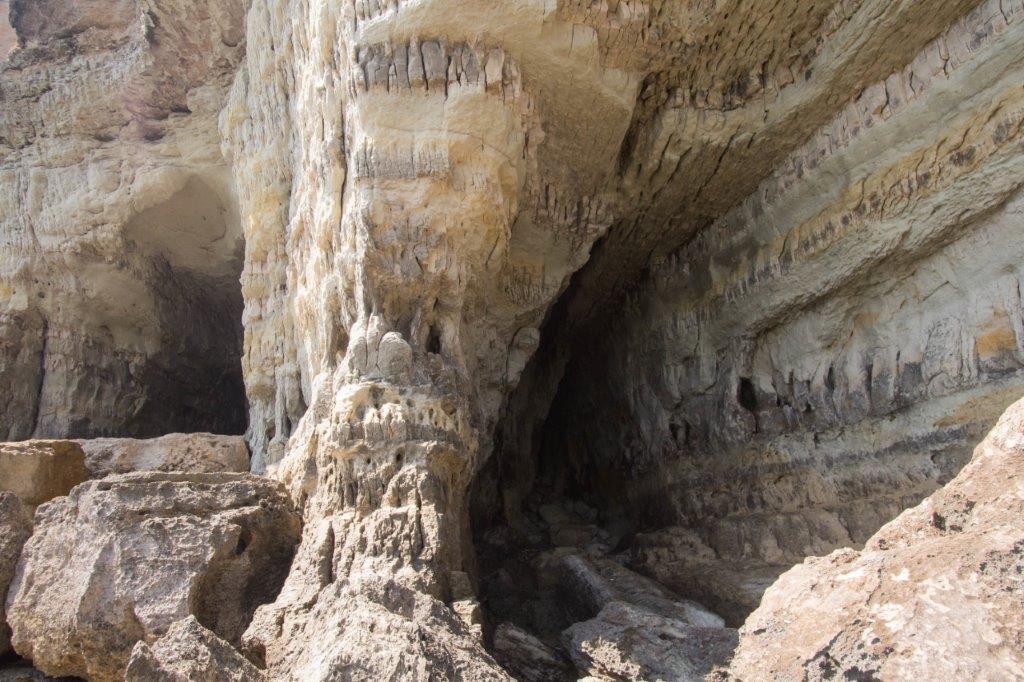
However, there were two more large caves in the cove. The first I called The Purple Temple. It was the smallest ‘big cave’ but had a unique charm. You entered it by wading through a narrow channel and into a large square ‘room’. Again, the rock strata looked like pillars and the floor and lower walls were covered in purple lichen.


At the back of the room, a tunnel led inwards towards the inner sanctum (as I thought of it). I could imagine candles and statues of gods in the alcove at the far end.

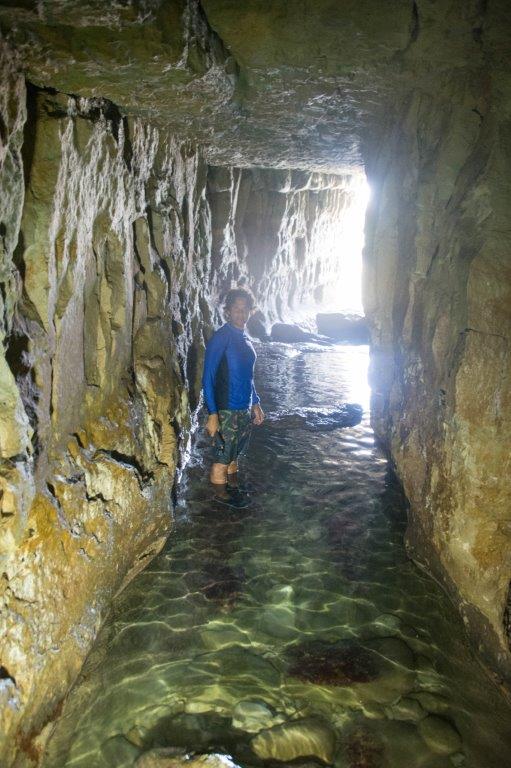
The third and final big cave was at the western end of the cove. To get to it, we had to climb over massive boulders that were sharp and scraped up my legs as I pulled myself over them.

The western end of the cove definitely appeared more . . . crumbly. The entrance to the final cave was strewn with boulders from earlier rock falls. This cave was wider than the others, with a low ceiling. Out of the three caves, this one felt the most cave-like and stank of bird poo. No images of temples or fairy palaces entered my head. Just cavemen in a dusty, smelly cave.


The cave stretched back a fair way and we had to crouch as we got further in. The roof above us was encrusted with ancient shells. It was amazing to think that this rock would have once sat at the bottom of the sea.

When we reached the far end, I could see that the cave continued on into different chambers. But you’d have to wriggle through on your stomach. This cave felt like the one most likely to collapse, so I didn’t want to risk squeezing into any nooks and crannies. We didn’t stay long.


The boulders at this end of the cove were so big that we were able to climb up them and back onto the cliffs overlooking the cove.
We were boiling by the time we got back to the car, so we grabbed our snorkels and fins and climbed back down the cliff and into the sea. Ah!! The relief!

The snorkelling inside the cove was average. We saw the usual suspects; bream, wrasse, goatfish. Perhaps there are more fish when there aren’t as many people in the cove.

I was thrilled to have finally explored the Cape Greco sea caves. And a tad relieved too. They hadn’t fallen on our heads. We hadn’t orphaned our children.
All joking aside, I’m not writing this blog with the intention of encouraging people to explore the sea caves. If the experts say there’s an imminent risk of collapse, I’m sure they are right. It certainly looked very dodgy in places. I’m writing this post simply to show photos of what the caves were like inside. Perhaps if I’d been able to find photos of these caves online, I wouldn’t have wanted to run the risk and explore them myself.
Oh, who am I kidding?! Of course I’d have wanted to explore them!
They were AWESOME!!!!!
Awesome! It is so great to see inside them, especially as I am not brave enough to explore them myself!
2 Comments